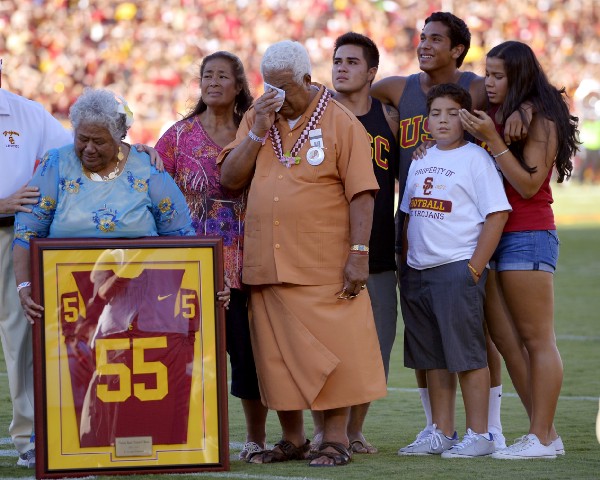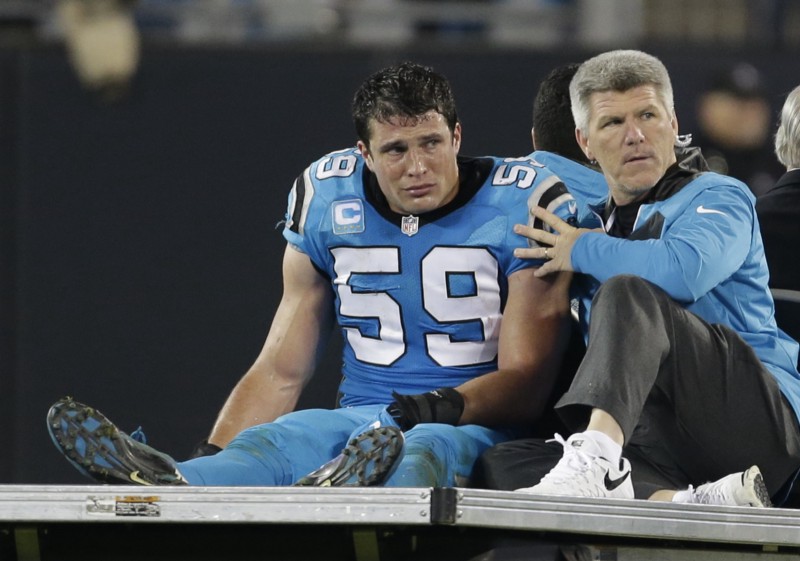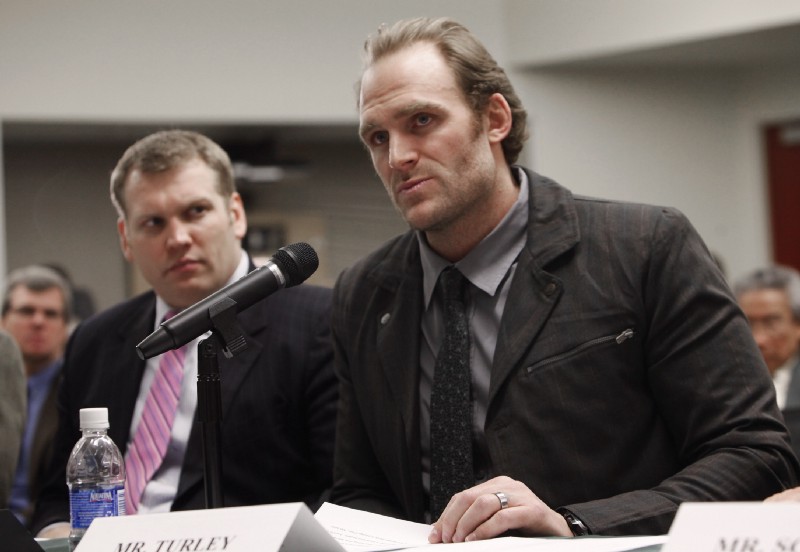On Monday, the first annual CTE Awareness Day, the family of late NFL star Junior Seau addressed a crowd at a press conference in Houston about the importance of brain donation.
“Junior is telling me that I need to speak for him,” Mary Seau, Junior’s sister, said, as reported by VICE Sports. “We want to let people know to take care of their brains. That the brain is the most important part of the body.”
She was speaking on behalf of “Faces of CTE,” a campaign launched by concussion and sport safety advocate Kimberly Archie. Archie’s son, Paul, was diagnosed with chronic traumatic encephalopathy (CTE), the degenerative brain disease found in people who have , after his death at the age of 24. The purpose of the campaign is to bring families who have been impacted by CTE together and to encourage people to donate their brains to the Mayo Clinic Brain Bank, where they can be posthumously studied.

The timing and location of the event is not a coincidence. This Sunday, over 100 million people will tune in to watch Super Bowl LI between the New England Patriots and Atlanta Falcons at NGR Stadium in Houston. In between the commercials and Lady Gaga’s halftime performance, the viewers will be watching brain trauma occur in real time.
Archie wanted the Faces of CTE campaign to serve as a reminder that the business of the NFL isn’t just providing entertainment: it’s enabling a public health crisis.
The NFL has taken significant steps toward making the sport safer over the last few years, such as making helmet-to-helmet hits illegal and establishing a concussion protocol that includes spotters in the stands. But, particularly after a season that saw — among other things — helmet-to-helmet hits on 2015 NFL MVP Cam Newton go unflagged; four-time pro bowler Luke Kuechly sobbing and disoriented after being concussed on a nationally televised game; and a botched execution of the concussion protocol after a hit on Miami Dolphins quarterback Matt Moore in the playoffs, most people agree that the league still isn’t doing nearly enough.
One person, however, thinks the NFL is actually doing far too much to protect its players these days. That person just happens to be our president.
The NFL has just barred ball carriers from using helmet as contact. What is happening to the sport? The beginning of the end.
— Donald J. Trump (@realDonaldTrump) March 20, 2013
Throughout his campaign, Trump complained that “football has become soft like our country has become soft.”
At a rally in Florida last October, after one of his supporters fainted, Trump even openly mocked the NFL’s concussion protocol.
“That woman was out cold, and now she’s coming back,” he said. “See, we don’t go by these new, and very much softer, NFL rules. Concussions — ‘Uh oh, got a little ding on the head? No, no, you can’t play for the rest of the season’ — our people are tough.”
ThinkProgress talked to concussion researchers, educators, advocates, and experts about the impact that Trump’s dismissive attitude toward the dangers of concussions could have on the future of concussion diagnosis and treatment. In between the many unknowns, we have significant reasons to be concerned about the impact that Trump’s rhetoric will have, his willingness to provide federal funding for research, and his administration’s openness to enacting meaningful legislation on the subject — along with one fairly strange reason to have hope.
Understanding the problem
Before it’s possible to see how Trump fits into any of this, it’s important to understand the scope of the problem.
Right now, the Center for Disease Control (CDC) estimates approximately 3.8 million concussions occur in the United States each year — and many experts believe that estimate to be very conservative. However, only one in six concussions are diagnosed.
Concussions continue to be difficult to diagnose because so few — even in the medical community — understand the symptoms of a concussion and how to properly treat them. However, there have been significant gains in concussion research and treatment over the past decade.

In 2006, Dr. Bennett Omalu, diagnosed the first case of CTE in the brain of the late great NFL center Mike Webster in 2006. CTE, which can only be diagnosed posthumously, leads to dementia, mood swings, depression, substance abuse, and even death. The Veterans Affairs-Boston University Brain Bank has examined the brains of 95 former NFL players; 91 of them have been diagnosed with CTE.
(It’s important to note that while they are both brain injuries, you can be diagnosed with CTE without ever having been diagnosed with a concussion, and concussions to not guarantee you will get CTE.)
But experts consider concussions in the NFL as only the “tip of the iceberg” — while there about 2,000 NFL players, there are 100,000 college football players, 1.3 million high-school football players, and 3.5 million youth football players. This doesn’t even include the millions of other athletes in soccer, basketball, rugby, lacrosse, hockey, baseball, and so on, who are at risk of getting concussions.
Because their equipment isn’t as regulated (there are no standards for youth football helmets) and their brains are still developing, head injuries can be particularly detrimental to kids. Dr. Ann McKee, the director of the CTE Center at Boston University, said that the brain damage she’s seen in youth football players “took my breath away.”
The government’s role in the crisis
While it might seem like this is an issue that the NFL, NCAA, and the medical community should address, the truth is, the government has a big role to play in solving this problem.
The most famous case of a president intervening in football safety occurred in 1905, when President Teddy Roosevelt convened a meeting of coaches and athletic administrators from Harvard, Yale, and Princeton to discuss how to make the game safer after at least 45 football players died from 1900 to 1905.

Football safety didn’t make waves in Washington, D.C. again for over a century, until President Barack Obama took office. In 2009, NFL commissioner Roger Goodell testified in front of the House Judiciary Committee, where he was grilled on the connection between the NFL and CTE, and whether the league had ignored science on concussions.
Then, in 2014, months after Obama told reporters that if he’d had a son, he wouldn’t permit his son to play professional football, Obama hosted a Healthy Kids & Safe Sports Concussion Summit, bringing together athletes, parents, coaches, and industry stakeholders to discuss how to make sports safer and diagnose and treat concussions more effectively. Along with the summit, Obama announced that the NCAA and the Department of Defense were jointly committing $30 million for concussion education and the most comprehensive concussion study ever, involving up to 37,000 college athletes.
The concussion summit got mixed reviews — Archie saw it as a “publicity stunt” that served as a “press conference for the NFL.”
Chris Nowinski, co-founder and executive director of the Concussion Legacy Foundation, agreed that the corporate presence at the summit reduced its effectiveness. Organizations who are heavily profiting from football, such as the NFL and NCAA, have an invested interest in maintaining the status quo.
“The federal funding from that grant directly impacts what we’re doing in the trenches.”
However, Nowinski was still “very pleased” that the summit was held — the summit, combined with Obama’s well-publicized comments about the dangers of youth football, helped significantly raise public awareness about the dangers of youth football. And, though he doesn’t think that $30 million is nearly enough funding, it will have a positive impact.
Dr. Jessica Schwartz, a Doctor of Physical Therapy, concussion survivor, and creator and program director of the world’s first post-professional concussion education program, Evidence in Motion, agrees. She told ThinkProgress that the funding has already had a hugely positive impact on concussion research and advancements in the treatments of traumatic brain injuries.
“The federal funding from that grant directly impacts what we’re doing in the trenches,” she said. “What this federal funding is doing is giving us the troops on the ground and allowing us to see where the trajectory of the injury goes.”
Trump’s potential impact
The concern, of course, is that any progress made under Obama’s administration will be slowed, halted, or even reversed during Trump’s time in office.
His words on the subject certainly aren’t inspiring confidence.
“We don’t joke around about head injuries in the medical community. We no longer call them dings to the head or getting your bell rung,” Schwartz said. “We don’t call people soft or imply they’re not tough when they’re going through chemo.”
Nowinski agrees.
“Saying football has gotten weak because of better concussion care is not a positive message you want to hear,” he said. “I don’t think he’s really changing minds, but you do worry about the people who agree with him being emboldened.”
“Saying football has gotten weak because of better concussion care is not a positive message you want to hear.”
(Mike Freeman of Bleacher Report reported after the election that an anonymous team executive told him that he believed that during Trump’s presidency, the NFL will become even more popular because “the country will care less about truth or facts” and will be “more accepting of football’s violence and the damage it does to the body.” Apparently, recent polling shows there might be some truth to that.)
While Archie also is not a fan of the way Trump talks about concussions, she’s much more worried about the minimal regard he shows for science, his desire to slash funding dramatically on everything except wall constructions, and, well, his general temperament.
“I think there’s always a concern when there’s a change in guard, and then you have the behavior of this president — he is obviously not going to be about regulation,” she said.
But she has focused in on one part of his personality that she hopes will save the day: his desire for revenge.
“The only hope is that since he hates Roger Goodell so much and feels that he’s been slighted, that somehow might help,” she said.
Archie is referring to Trump’s hatred for the NFL, which boiled over in 2014, the year that Trump set his sights on purchasing an NFL franchise, the Buffalo Bills. He spent lots of time on twitter talking to his fans about this goal — often tagging commissioner Goodell in his tweets.
"@AndyLeeTweets: I'd rather @realDonaldTrump run for president than buy our football team." Interesting point!
— Donald J. Trump (@realDonaldTrump) April 17, 2014
"@Cknikita I'd♡ Love ♡Donald Trump to buy the @buffalobills and Also run for Our President! #Super Deal #Double #Win Win!" Thx.@nflcommish
— Donald J. Trump (@realDonaldTrump) April 17, 2014
"@Alertora27 If @realDonaldTrump does buy the Buffalo Bills, they could become a winning team in the near future" Thanks. @nflcommish
— Donald J. Trump (@realDonaldTrump) April 16, 2014
Ultimately, Trump’s $1 billion bid for the Bills was topped by the Pegula family’s $1.4 billion bid, and, well, the rest is history. (There are theories that if Trump had been successful in buying the Bills, he wouldn’t have felt the need to run for president. So that’s something to mull over as you check the news each morning.)
After he lost out on NFL ownership, Trump’s tone towards the league changed.
I'm not going to be watching much NFL football anymore. Too time consuming, too boring, too many flags and too soft. Focus on other things!
— Donald J. Trump (@realDonaldTrump) October 6, 2014
Archie’s ultimate dream is to create a new federal agency, the Sports Health and Safety Administration, which is partially funded by a small tax on every NFL ticket sold. She wants this agency to be in charge of initiatives such as mandating that kids only play flag football into high school, establishing a hit count for football players (like a pitch count in baseball) to limit their exposure to hits when they’re still minors, and oversee regulations for helmets and other sporting equipment for kids.
“Because of that issue between him and the NFL, I feel there’s a window of possibility,” she said. “I do have this flicker of hope, maybe it’s based on a pie in the sky.”
Next steps
While Archie’s ask might seem like a long-shot, there are reasons to be cautiously optimistic. First, there’s the fact that a lot of sports concussion research is directly tied with military concussion research, which could provide more incentive to keep studies funded.
But there’s also the fact that right now, concussion research is riding a pretty strong wave.
“A lot of momentum has been created that can only get bigger. The research departments that have been launched, the equipment, it’s moving as fast as it ever has,” Chris Nowinski said.

“We’ve made more advancements in brain research in the last 10 years than we have in the last 10,000 years,” Schwartz said. “That’s going to exponentially grow from this federal funding research.”
One of the many promising studies that came out recently was published by the National Institute of Healthy by Dr. Jessica Gill, who discovered a biomarker in blood that seems to help predict recovery time for sports concussions.
This is significant because it’s crucial that an athlete fully heals from a concussion before returning to the field of play, and Gill’s research shows that measuring the concentration of the blood protein tau in athletes could take the bias and guess-work out of that decision making process.
For Gill, who deals with concerned parents all the time who just want definitive answers about the long-term health of their children who have suffered concussions, the results of this research give her hope that one day, she will be able to give them the reassurance they want. But there’s a long way to go until she gets there. Further studies need to be done in order to monitor athletes for longer, and to figure out if taking samples even sooner after their injuries — say, one hour as opposed to six hours — will produced similar results. Additionally, scientists need to develop technology to make measuring tau more efficient and convenient.
“We’ve made more advancements in brain research in the last 10 years than we have in the last 10,000 years.”
According to Gill, right now, “measuring tau is like measuring grains of sand in an Olympic-sized swimming pool.” There’s a long way to go until this is a reliable system that can be used in real-time on the sidelines.
This is why it’s crucial that Gill be able to continue along this research path. But, considering all of her work is federally funded, there are no guarantees.
“In the federal government we’re always nervous no matter what because a lot of priorities change and we have no idea where the funding would go next,” she said.
With this administration change, the uncertainties seem to be endless. But that doesn’t mean that those who are concerned about the future of concussion research should just sit back and fret.
According to the experts, private organizations and nonprofits, families and friends of those impacted by CTE, survivors of concussions, to all ban together. They need to lobby in D.C. frequently. They need to push themselves on the radar of large organizations, and form a cohesive foundation. They need to make themselves heard.
“We need to responsibly use the press to get the message out to the public that we’re here for you, and we’re working for you with the tax dollars we all pay into every year,’” Schwartz said.
“I hope that the new administration can be reflective and respectful demonstrating a think first, speak later, and fund now approach — as opposed to the reciprocal. We can’t let potential funding issues distract us from what our roles and responsibilities are to our patients as people.”
